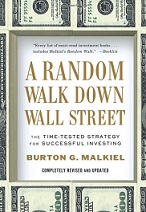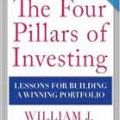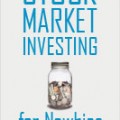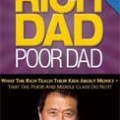There are hundreds of investment and stock trading books out there. I’ve purchased and read a few of them over the years (mainly in the stock trading and day trading arena). These were OK books that explained the details of how the market works on a VERY microscopic level, but following their advice actually lost me handfuls of money 🙁
Recently, I set a monthly goal to read the book A Random Walk Down Wall Streetby Burton Malkiel
. I could tell before I was even halfway through the book that it would change my life forever in an extremely positive way!
Contents and the Basic Premise of “A Random Walk Down Wall Street”
Malkiel has written a number of investing books over the past 50 years, but A Random Walk Down Wall Street is the book he is most famous for. The basic premise of A Random Walk Down Wall Street
is that the markets are perfectly efficient in the long run. This efficient market hypothesis (EMH) means that all bubbles will eventually self correct, and that all stocks will eventually revert back to their true value after some period of time.
Investors often disagree on what the “true value” of stocks are, and from time to time market bubbles form. There are many different methods to estimate what the “true value” of a stock it, but in the end the EMH always holds true and stocks revert back to their true value. Malkiel covers several examples of bubbles and their eventual bursting going all the way back to the dutch tulip mania of the 1600’s.
The book dissects several different types of investing/trading systems that are used and basically proves that none of these can beat buy and hold investing in market index funds over the long term because of the EMH.
A Random Walk Down Wall Street is broken down into four main sections:
- Stocks and their value – This section discusses fundamental analysis and technical analysis. This describes different methods for how investors attempt to assess a stock’s true market value.
- How the pros play the stock market – This section covers actively managed funds and their performance relative to market index funds. It also addresses active trading and market timing.
- Modern portfolio theory – Here Malkiel discusses the newer theory that investors are rewarded with higher returns only on the additional amount of non-diversifiable risk they are willing to undertake.
- Practical guide section for getting started – Here several example portfolios are presented with specific mutual fund ticker symbols if you’re ready to jump in and get started.
What I Didn’t Like About “A Random Walk Down Wall Street”
Overall, A Random Walk Down Wall Street was a good read, but I do have just a few criticisms of the book. Most of these are pretty nitpicky. Here they are in no particular order.
- The book is really long (450+ pages!). In many areas Malkiel takes a very long time to get to the point. This is OK for someone like me that likes some of the details, but it got a bit much at times.
- The fourth section where he lays out the practical guide could have been a bit more organized. It feels kinda like a data dump at the last minute.
- The book does a good job of getting across investing concepts, but isn’t great at giving the reader actionable steps to help get them jump started. It assumes you already have an investment or retirement account.
- Parts of the book are pretty complicated, and I had to re-read a couple sections to fully understand the concepts. You may find some of the concepts presented a little complicated if you’re new to investing, but this shouldn’t put you off from reading the book IMHO.
What I Loved About “A Random Walk Down Wall Street”
Overall, I really loved A Random Walk Down Wall Street. If someone had beat me over the head and forced me to read this book 15 years ago, I’d be so far ahead of where I am today that it’s almost depressing!
There are so many gems of useful information in this book, I can’t really do it justice here in this review. While it is a long read, I think just about reader would benefit from it unless you are truly an investing expert. Here are some of the reasons I loved this book:
- Malkiel gives great descriptions of many of the historical bubbles throughout human history. From the 1600’s tulip mania all the way to the most recent credit crisis in 2008, he covers each formation and pop in great detail. I found this fascinating.
- Malkiel compares buying and holding market index funds to many other types of investing strategies that have been developed over the past 70 years. Malkiel expertly cuts through all the investing crap and explicitly shows why each method is worse than buy and hold. He proves all of this academically and with historical market data.
- The author gives discussion as to why market timing is a complete waste of time and will ALWAYS leave you worse off over the long run. If I had read this book 15 years ago, this point alone could literally have saved/made me hundreds of thousands of dollars by now. At least I know going forward that I would be doing myself more harm than good by trying to time the market.
- He gives a perfect description of the random walk theory and why this can help to explain nearly all of the stock market variation and those “hot shot” fund managers that seem to come out of nowhere, take the world by storm, and fizzle out back into the shadows.
- I really love the humorous examples he uses throughout the book. One that sticks in my mind is an illustration of the efficient market hypothesis and attempts to beat the market averages:
- It takes place with a conversation between and economist and a student. As they are walking down the sidewalk, the student notices what he thinks is a $100 bill on the sidewalk. “Did you see that? It’s a $100 bill,” the student exclaims. “Don’t bother picking it up,” the economist says. “If it really were a $100 bill, someone else would have picked it up by now. So, don’t waste your time. We know that it can’t be a $100 bill.” For me, this perfectly illustrated the debate between being able to beat the market averages and the efficient market hypothesis! Good deals are around, buy you’ve literally got millions of people looking around for those loose $100 bills, so they won’t last but for a second before they’re corrected. This means it is nearly impossible to beat the market average in the long run!!!
Book Review – A Random Walk Down Wall Street – Rating
4/5 Stars – A little on the long and complicated side, but worth it if you can get past that.
Who Should Read “A Random Walk Down Wall Street“
Unless you’re a recognized investing master, I highly recommend picking up a copy of A Random Walk Down Wall Street from the library or Amazon. There really is something here for everyone who is interested in increasing their wealth. I learned so much from this book around I can improve at investing that it isn’t even funny. I can honestly say to you that this book will change the rest of my life in a hugely positive way! How many times do we get to say that?!? Please do your future self a favor make the commitment to read it today!










Hey Derek,
Actually a friend of mine just gave me this book, unfortunately I just left it on my kitchen table. Man 450 pages is a long book, but it changed my friend’s investing outlook.
Charles@gettingarichlife recently posted…Do You Know The Difference Between Twerking And An ETF?
Charles, it really is a kick-ass book. I highly recommend you check it out – it really will change your life!
dear Derek,very good analysis,after reading your post i am much interested to read this book,but unfortunately this book is not available in our local markets as i live in rural area of India,so how can i get this book online,plz suggest.
madan ojha recently posted…Indian Stock Markets Opened Negative,Down by more than 1 %.
Madan,
I’d try Amazon or ebay. You can probably pay the extra for international delivery. They have a kindle version on the india amazon website. You could purchase this and read it through the amazon online cloud viewer I believe. Good luck!
This book is among ten “money books” that am trying to read by the end of the year. Maybe I should bump it into the front of the queue, wouldn’t want to be regretting three months down the line on something I could have implimented into my investments 🙂
Simon @ Modest Money recently posted…Barclaycard Rewards MasterCard Review
Simon,
Based on what you already know about saving, I’d highly recommend you move it towards the top of your list! What other books are on your ten “money books”?
Having already read The Intelligent Investor before reading this, I pretty much skimmed the entire book until I got to the section on index funds and asset allocation. His age-based allocation graphs are staples in the financial planning world.
Bobby @ Making Money Fast and Slow recently posted…Markets Get A Boost From Jobs Report